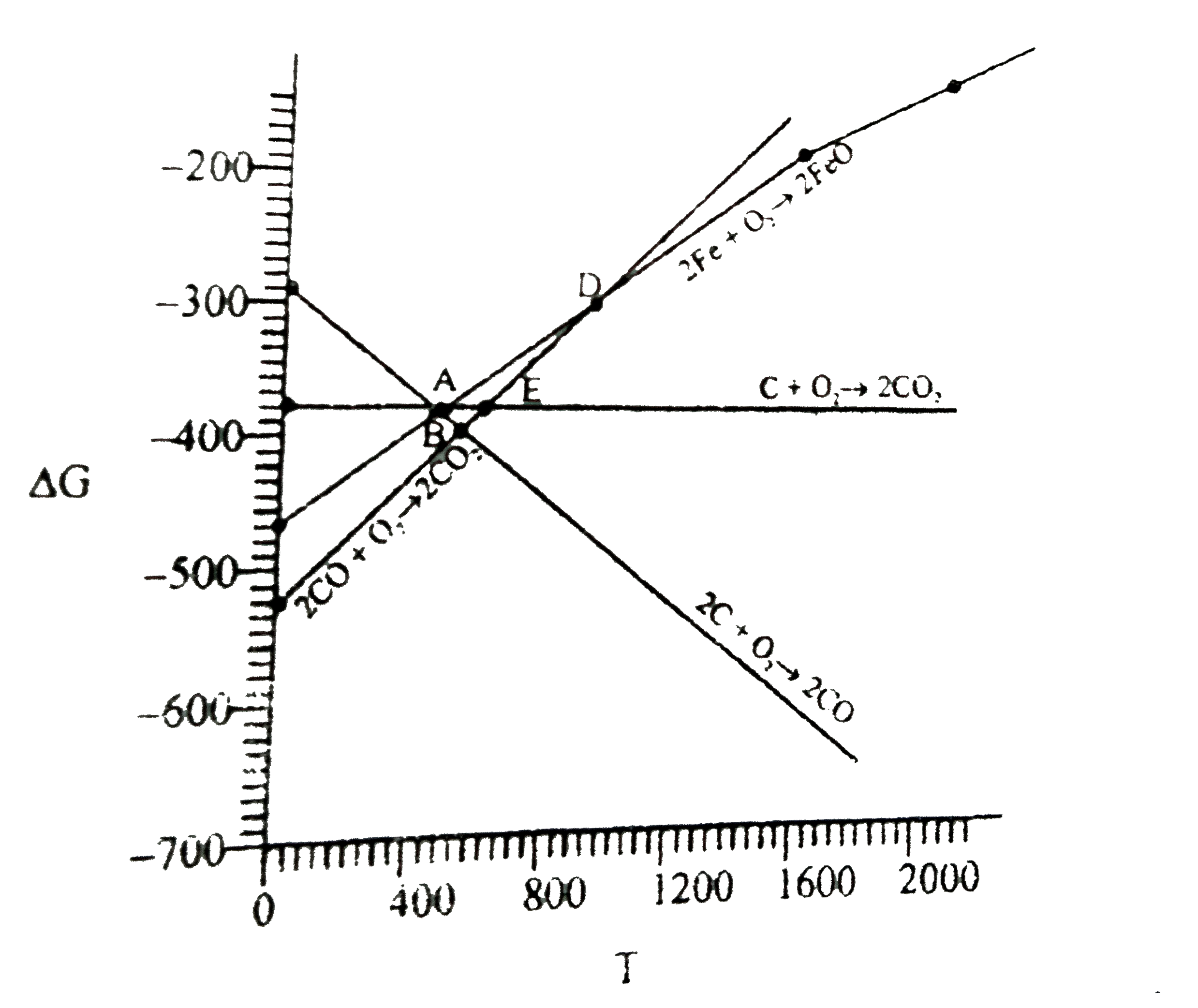For the reduction of at the temperature corresponding to point D, which of the following statements is correct?

value for the overall reduction reaction with carbon monoxide is zero.
value for the overall reduction reaction with a mixture of 1 mol carbon and 1 mol oxygen is positive.
value for the overall reduction reaction with a mixture of 2 mol carbon and 1 mol oxygen will be positive.
value for the overal reduction reaction with carbon monoxide is negative .
The correct Answer is:A
curve for the formation of FeO from Fe and that of from CO intersect at point D and therefore for the overall reduction of FeO with CO is Zero.
Topper's Solved these Questions
- BOOK - MODERN PUBLICATIONCHAPTER - GENERAL PRINCIPLES AND PROCESSES OF ISOLATION OF ELEMENTSEXERCISE - NCERT FILE (Ncert Exemplar Problems) (Multiple Choice Questions (Type-II))13videos
GENERAL PRINCIPLES AND PROCESSES OF ISOLATION OF ELEMENTS
- BOOK - MODERN PUBLICATIONCHAPTER - GENERAL PRINCIPLES AND PROCESSES OF ISOLATION OF ELEMENTSEXERCISE - NCERT FILE (Ncert Exemplar Problems) (Short Answer Type Questions)18videos
GENERAL PRINCIPLES AND PROCESSES OF ISOLATION OF ELEMENTS
- BOOK - MODERN PUBLICATIONCHAPTER - GENERAL PRINCIPLES AND PROCESSES OF ISOLATION OF ELEMENTSEXERCISE - NCERT FILE (Ncert Textbook Exercises)27videos
GENERAL PRINCIPLES AND PROCESSES OF ISOLATION OF ELEMENTS
- BOOK - MODERN PUBLICATIONCHAPTER - ELECTROCHEMISTRY EXERCISE - UNIT PRACTICE TEST20videos
ELECTROCHEMISTRY
- BOOK - MODERN PUBLICATIONCHAPTER - HALOALKANES AND HALOARENESEXERCISE - UNIT PRACTICE TEST11videos
HALOALKANES AND HALOARENES
Similar Questions
Knowledge Check
- Question 1 - Select One
Which of the following statements is not correct ?
AThe number of carbon atoms in an unit cell of diamond is 4BThe number of Bravais lattices in which a crystal can be categorized is 14CThe fraction of the total volume occupied by the atoms in a primitive cell is 0.48DMolecular solids are generally volatile - Question 2 - Select One
Which of the following statement is not correct ?
AProvision for Doubtful Debts Account is amount payable to debtors.BBad Debts can be more than the amount of Provision for Doubtful Debts.CBad Debts can be less than than amount of Provision for Doubtful Debt.DProvision for Doubtful Debts is shown in the Balance Sheet. - Question 3 - Select One or More
For the reaction
A+B→2C+D which of the following statements is/are correct?ARate of disappearance of B = 1/2 x rate of appearance of CBRate of disappearance of B =1/2 x rate of appearance of CCRate of disappearance of A = rate of appearance of BDRate of disapperance of A = rate of disapperance of B.
For the reaction of 4A+B→2C+D.. Which of the following statements is correct ?
View SolutionWhich one of the following statements about temperature is correct?
View SolutionAlthough, nitrogen does not adsorb on a surface at room temperature, it adsorbs on the surface at 83 K. Which one of the following statements is correct?
View SolutionAlthough, nitrogen does not adsorb on a surface at room temperature, it adsorbs on the surface at 83 K. Which one of the following statements is correct?
View SolutionWhich of the following reduction processes are correct
View Solution

